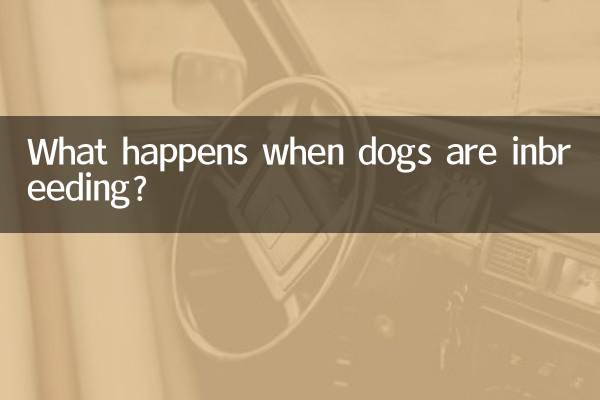What happens when dogs are inbreeding?
In recent years, there has been an increasing discussion about pet breeding, especially the issue of inbreeding in dogs, which has attracted widespread attention. Inbreeding refers to the mating between closely related individuals. This behavior is not uncommon in dog breeding, but the potential risks it brings cannot be ignored. This article will combine the hot topics and hot content on the Internet in the past 10 days to discuss the consequences of dog inbreeding and provide structured data for reference.
1. The definition and common causes of inbreeding

Inbreeding usually refers to the mating of related dogs within three generations. This behavior is relatively common in dog breeding, and the main reasons include:
2. Potential risks of inbreeding
Inbreeding can lead to a range of health and behavioral problems. Here are the main risks:
| Risk type | Specific performance | probability of occurrence |
|---|---|---|
| genetic disease | Hip dysplasia, heart disease, etc. | Increase 30-50% |
| Decreased immunity | Susceptible to diseases and slow to recover | 40% increase |
| Decreased fertility | Infertility, reduced litter size | 25% increase |
| behavioral problems | Increased aggression and decreased learning ability | 20% increase |
3. Scientific data on inbreeding
According to the latest research data, the extent of the impact of inbreeding on dogs can be demonstrated in the following table:
| Inbreeding coefficient | health effects | Typical varieties |
|---|---|---|
| 12.5% (cousins) | slight increased risk | most varieties |
| 25% (brother and sister/parent-child) | Significantly increased risk | Common in purebred dogs |
| 50% (parent-child duplication) | serious health problems | extreme case |
4. How to avoid the negative effects of inbreeding
1.Genetic testing:Conduct DNA testing before breeding to understand the genetic status of the dog.
2.Expand the gene pool:Introducing external bloodlines to increase population diversity.
3.Professional guidance:Consult a veterinarian or professional breeder for scientific advice.
4.Tracing your lineage:Establish complete pedigree records to avoid accidental inbreeding.
5. Changes in public attitudes towards inbreeding
Distribution of opinions based on recent hot discussions on the Internet:
| opinion type | Proportion | main argument |
|---|---|---|
| Firmly oppose | 45% | Animal welfare first |
| Conditionally accepted | 35% | Controllable under professional management |
| It doesn't matter | 15% | Don't understand the impact |
| support | 5% | Maintain variety characteristics |
6. Expert advice
1.Moderate breeding:Even professional breeders should strictly control the frequency of inbreeding.
2.Health first:Breed standards should not come at the expense of dog health.
3.Public education:Improve ordinary dog owners’ understanding of breeding knowledge and reduce non-professional inbreeding.
4.Improved regulations:Call for the establishment of better dog breeding management practices.
7. Conclusion
Inbreeding of dogs is a complex issue involving many factors such as animal welfare and breed protection. Through scientific understanding and a responsible approach, we can maximize the health and welfare of dogs while maintaining their breed identity. We hope that the structured data and information provided in this article will help readers gain a more comprehensive understanding of this important issue.

check the details

check the details